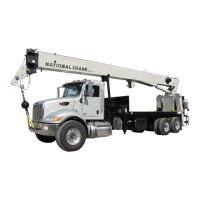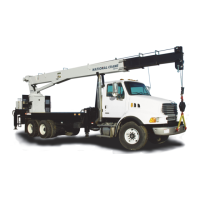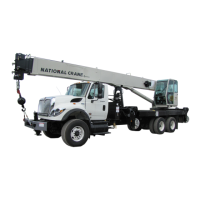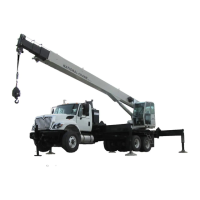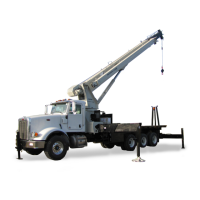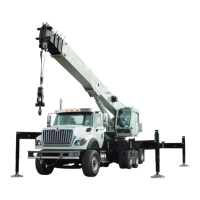REPAIR 800D
6-16
Published 5-27-2018 Control # 039-06
Front Bottom Pad Replacement
1. Extend boom approximately 4 ft (120 cm) out.
2. Remove cable guides and upper spacer bars from front
of boom sections
3. Loosen and remove hex nuts on retract cables on the
front of the 1st and 2nd sections
4. Using an appropriate lifting device, sling around the 4th
section boom and lift it up until weight is removed from
the bottom pads in the front of the 3rd, 2nd, and 1st
boom sections.
5. Loosen and remove the four capscrews holding the pad
doubler plate in between the 4th and 3rd sections.
Remove plate. Remove pads from this plate. Note all
pad locations and tag accordingly.
6. Loosen and remove the four capscrews holding the pad
doubler plate in between the 3rd and 2nd sections.
Remove plate. Remove pads from this plate. Note all
pad locations and tag accordingly.
7. Loosen and remove the four capscrews holding the pads
in between the 2nd and 1st sections. Remove pads.
Note all pad locations and tag accordingly.
8. Inspect pads for wear using previously mentioned
inspection criteria.
9. Install new pads with Teflon inserts on plates or boom
sections. Reassemble plates in boom in proper
locations.
BOOM CABLE TENSIONING
A boom assembly is considered properly timed when
telescoping sections extend equally relative to each other
and bottom out simultaneously at full retraction and do not
spring back out after retract pressure is returned to neutral.
Hydraulic extend cylinder construction will dictate which
extendable section will be the driver that the other extend
sections will need to be adjusted to utilizing cable
adjustment.
A single stage cylinder will control first extendable section.
A dual stage cylinder will control second extendable section.
Timing sequence of cables will depend on number of
sections and the extend cylinder construction.
Design intent of the cable tensioning is to balance the
preload of extend and retract cables for each extendable
section. In addition, sequencing of the sections during
retraction requires retract cables of every section to be
indexed relative to each other.
Cable Tensioning
Tensioning Setup Procedure
Tensioning must be done with the boom in the horizontal
position.
When tightening/loosening the first (adjustment) nuts on
cables, secure cable using the wrench flats at the front of the
cable ends to prevent cable twist. Excess twisting of cables
can cause premature failure.
Ensure boom is completely assembled and fully retracted.
1. Mark the front of each section with a chalk line as
indicated in Figure 6-1.
2. Extend and retract boom several times to establish
working state of cables.
3. Extend boom so scribed lines are exposed by
approximately 12 inches.
4. Measure the extension gaps between each boom
section and scribed line and note values.
5. Retract boom so that the scribed lines are exposed by
approximately 6 inches.
6. Measure the retraction gaps between each boom
section and scribed line and note values.
7. Extend and retract the boom a few times and then
repeat measuring the extension gaps.
8. Adjust all corresponding cables according to
Cable
Tightening Sequence
instructions.
Fo
r
Reference
Only
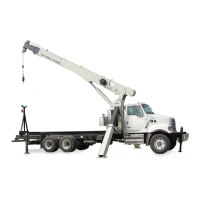
